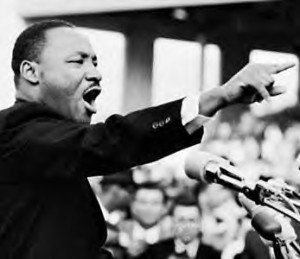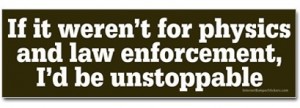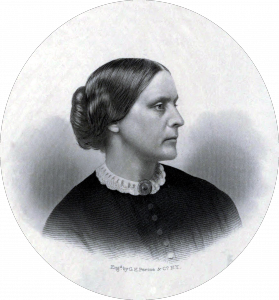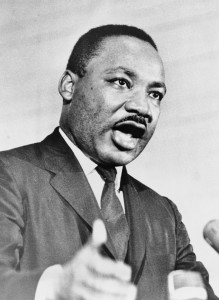Tuesday, March 18, 2014 8:10 pm
In Chapter 22, rhetoric is defined as discovering all possible means of persuasion. There are three types of rhetorical proofs: logical (logos), ethical (ethos), and emotional (pathos). In any successful speech, the speaker should strive to accomplish all three types of rhetorical proofs. In Dr. Martin Luther King’s “I Have a Dream” speech has manages to hit all three proofs. The proof that I recognized the most was his use of emotional or pathos. Pathos is defined as “emotional proof, which comes from the feelings the speech draws out of those who hear it.” In one part of his speech in particular, Dr. King speaks directly to his audience pointing out their struggles in an attempt to bring their emotions to the surface.
“I am not unmindful that some of you have come here out of great trials and tribulations. Some of you have come fresh from narrow jail cells. And some of you have come from areas where your quest — quest for freedom left you battered by the storms of persecution and staggered by the winds of police brutality. You have been the veterans of creative suffering. Continue to work with the faith that unearned suffering is redemptive. Go back to Mississippi, go back to Alabama, go back to South Carolina, go back to Georgia, go back to Louisiana, go back to the slums and ghettos of our northern cities, knowing that somehow this situation can and will be changed.”
This is not meant to take advantage of his crowd; it is only spoken to help make his audience feel a certain type of way. This part of his speech starts with his audience thinking about the hard times in their life; however, he then switches the mood to give them hope that a better life is possible, allowing them to feel joy.

Tuesday, March 18, 2014 4:37 pm
Rhetoric, a concept developed by Aristotle, involves all possible means of persuasion and is broken up into three rhetorical proofs (logos, ethos, pathos). Logos, otherwise known as the logical proof, involves a term called the enthymeme which can best be understood as an incomplete version of a formal deductive syllogism. Enthymemes are often used by politicians in speeches, as can be seen in this NY Times article from 2003 regarding President Bush’s speech regarding the war on terror. In his speech, he states that'”the battle of Iraq is one victory in a war on terror that began on September the 11th, 2001, and still goes on. . . . With those attacks, the terrorists and their supporters declared war on the United States. And war is what they got”. This is a classic example of enthymematic argumentation. We were attacked on Sept. 11, so we went to war against Iraq. The missing piece of the argument, that Saddam was involved in 9/11, didn’t have to be said aloud in order for the audience to clearly understand Bush’s message.
Bush: War On Terror
Tuesday, March 18, 2014 5:15 am
From the early times of Greek civilization, philosophers, such as Aristotle, believed that rhetoric helps discover all possible means of persuasion. He classified rhetoric into three speech situations: forensic, epideictic, and deliberative. Forensic speaking is when one tries to persuade an audience upon past actions. Epideictic speaking occurs when one attempts to benefit a present-day audience. Lastly, deliberative speaking is used when one tries to influence an audience about future actions. Aristotle goes on to distinguish inartistic proofs, those that the speaker does not create, and artistic proofs, those that the speaker does create. The three types of artistic proofs are logical, ethical, and emotional. I was interested while reading about logical arguments. A logical proof, also known as logos, has two forms: the enthymeme and the example. An enthymeme is an incomplete argument where an obvious conclusion is left out. For example in a courtroom, lawyers often use logical proofs to sway the judge and the jury in their favor. They provide reasonable arguments by using testimonies and evidence to prove their position right. They rely on logic to influence the jury’s final verdict and win the case.

Tuesday, March 18, 2014 1:18 am
The notion of Rhetoric is seen as a message by “logical, ethical, and emotional proofs.” Inartistic and Artistic include two types of proofs. Inartistic proofs are created by the audience, while artistic is created by the speaker. Logos, pathos and ethos are the three types of artistic proofs. An example of ethos is seen in Earl Spencer’s eulogy for Princess Diana. He allows the audience to identify with him as a guardian by explaining that he recognizes “the need for them to experience as many different aspects of life as possible.” He constructs his own ethos by representing himself as a source of protection. As a result, people around the world could identify with Spencer’s relationship to Princess Diana. Attached is a video and link to the speech by Earl Spencer.
http://www.americanrhetoric.com/speeches/9thearlspencerdianaeulogy.htm
Earl Spencer
Monday, March 17, 2014 10:30 pm
In Chapter 22, I read about the theory on Rhetoric, which refers to an act of making persuasion possible. In contrast to Dialectic, rhetoric is the process of one person addressing the many. In order to make one’s persuasion powerful, one must be aware about the three rhetorical proofs; logical, ethical and Emotional. I really like when the text talks about how enthymeme is the most powerful tools to use in rhetoric. An enthymeme is created by making the final premise or the conclusion missing, and let the audience to be enlightened through self-realization. I attached a photo saying, “If it weren’t for Physics and law enforcement, I’d be unstoppable”. I find this enthymeme to be hilarious. From the statement we learn that it is ultimately because of physic and the laws of nature that cause us to be limited with our capabilities. But this understanding was not stated in the quote. The reason why an enthymeme is so powerful is because it allows one to gain insight from the saying through connecting the quote to one’s personal experience.

Monday, March 17, 2014 7:06 pm
Aristotle regarded rhetoric as “the art of discovering ways to make truth seem more probable to an audience that isn’t completely convinced (290).” Persuasive methods include inartistic or artistic proofs. Inartistic proofs describe “external evidence the speaker doesn’t create (290)” and artistic proofs describe internal proofs the speaker creates through logical (logos), ethical (ethos) and emotional (pathos). Logical proof arises from the actual argument itself, ethical proof demonstrates how the speaker shows his character through the speech and emotional proof describes the emotions the speech evokes on the audience. Susan B. Anthony’s speech in 1873 is a great example that contains logos, ethos and pathos. Anthony voted illegally in the 1872 presidential election and was tried by a jury in 1873 for her crime. Due to restrictions placed by the judge, Susan B. Anthony couldn’t take the stand and defend herself so she decided to give a speech to a number of towns before her trial. Anthony’s speech contained logical proof based on the United States Constitution; through the use of the Fourteenth Amendment she was able to show how prohibiting women to vote went against the Constitution itself. Anthony’s speech contained ethos through her authoritative writing style and regal attitude. Even though the court ignored her words, her speech is still studied and analyzed because of the immense effect it had on the later legalization of women’s right to vote. She used pathos by telling her story and showing vulnerability, she appealed to her audience’s emotions by convincing them that if her rights were being violated so could the rights of the audience members, and also touched on how important it is to fight for these rights and the Constitution.

Monday, March 17, 2014 5:51 pm
Rhetoric is a communication concept that has been utilized as long as spoken languages have been around but was strongly emphasized by Greek philosophers such as Aristotle as an important skill. It was taught a lot to young people who had interest in being politicians because of it aim, which is to be able to persuade and motivate people through language. Rhetoric maintains a very important part of our every day lives as people accomplish many things through their social interactions especially if they are capable of persuading people. An obvious example of the use of Rhetoric is in politics, the men and women running for political office must convince huge numbers of people to vote for them and believe in their cause. Another example that I prefer is activists such as Dr. Martin Luther King Jr. or Mahatma Gandhi, these men showed true poise in front of large numbers of people and were able to persuade through their words and the way that other people felt about them. In order to convince people to follow their causes they were brilliant in the way they made others feel warm through the way they spoke and carried themselves. Dr. Martin Luther King Jr. is as an orator was brilliant in his use of symbolism and ability to instill his own beliefs about the world in others.

Monday, March 17, 2014 3:46 am
The Rhetoric of Aristotle:
Aristotle believed that speakers used rhetoric, or the means of persuasion, as a way to “move the audience while showing a casual indifference to the truth (289).” He adds that it is a tool for the orator to “further fraud” his or her audience (289). Aristotle’s hypothesis is clearly evident in the movie There Will Be Blood, during which an oil tycoon, Daniel Plainview, meets with a township of people whom he is trying to convince them to sell him their land. Thereby, the speech he gives is a political, or deliberative, form of public address because it “attempts to influence legislators or voters who decide future policy” (290). In this example, the voters are the land-owning members of the town, as they get to decide if they will sell Daniel their land. At the beginning of the speech, Daniel attempts to establish all three forms “source credibility,” (292) which Aristotle states is essential in convincing voters. He explains that he is an “oil man” and adds that he has “many wells across the country,” which is his way of trying to show his “perceived intelligence” (291) in regard to the oil business. Next, he mentions that he is a “family man,” and even points to his son, which makes the audience believe that he is a “Virtuous Character” (291), when is reality he is not good nor honest about his attentions. Finally, Daniel talks about building a school, improving the lives of the children in the town, and creating irrigation to raise grain for the entire community, among other promises that he will bring to the town. Such rhetoric clearly exemplifies his attempt to establish Goodwill, as Daniel is an “intelligent character yet does not have the listeners’ best interest at heart” (291). Instead, Daniel is attempting to feign Goodwill, so that he can achieve his true goal of taking advantage of the township to make lots of money. Such promises are also “logos,” as they are logical arguments that come from Daniel’s speech – new roads, better education, and more food for everyone. Finally, Daniel uses “emotional proofs” (294) throughout his speech to convince the township that he will be a great contributor to their society. Namely, Daniel appeals to the “love or friendship versus hatred” proof in which, as Aristotle argues, the speaker “should point out common goals, experiences, attitudes, and desires. (294). Daniel’s use of such pathos is evident throughout the entire speech, and is a major contributing factor in convincing the township to sell him their land. Thereby, Daniel’s speech is extremely successful in completing his goal because he adheres to Aristotle’s beliefs on political rhetoric. The link the speech is attached below.
There Will Be Blood \”I\’m an oil man\” speech
Monday, March 17, 2014 3:28 am
The Speech from To Kill A Mockingbird shows a great example of rhetoric. The lawyer starts off buy using a great example of showing how the opponent is using an inartistic proof. In a court of law this should be a damning factor. This case is influenced because the defendant is African American. He is going to have to go above and beyond the usual argument. The start is a beautiful illustration of poking a hole in his opponents argument. As the defendant this is all he needs to do is disprove the oppositions argument and he goes about it quickly by pointing out this inartistic proof
Monday, March 17, 2014 3:06 am
The Rhetoric of
Aristotle
Rhetoric is defined as “discovering all possible means of persuasion” and Aristotle refers to the available means of persuasion as either artistic or inartistic. Artistic are the kind of proofs that the speaker creates the logos (logical proofs), ethos (ethical proofs) and pathos (emotionalproof). The given example, a speech given by Obama, deals with the war against the al Qaeda and the Taliban in Afghanistan and tries to convince his audience of his credibility. By given specific numbers and facts Obama shows that not only is he a credible source
but also worth the audience’s time. In order to be credible, the speaker, inthis case Obama, has to show intelligence, character and goodwill toward the audience. All those personal characteristics are revealed through his speech. His level of intelligence is shown by the vocabulary he uses.
Full speech: http://www.ontheissues.org/international/Barack_Obama_War_+_Peace.htm
Extract of Speech:
“I will end this war in Iraq responsibly, and
finish the fight against al Qaeda and the Taliban in Afghanistan. I will
rebuild our military to meet future conflicts. But I will also renew the tough,
direct diplomacy that can prevent Iran from obtaining nuclear
weapons and curb Russian aggression. I will build new partnerships to
defeat the threats of the 21st century: terrorism and nuclear proliferation;
poverty and genocide; climate change and disease. And I will restore our moral
standing, so that America is once again that last, best hope for all who are
called to the cause of freedom, who long for lives of peace, and who yearn for
a better future.”







